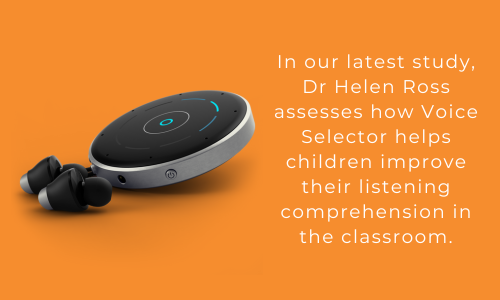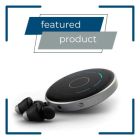Listening and learning: How Voice Selector can help children with ADHD in learning environments

Voice Selector uses acoustic beamforming technology to give students better control over what they hear in the classroom, allowing them to focus on the teacher’s voice while reducing background noise. It improves speech intelligibility to make listening experiences in noisy environments easier, while freeing up cognitive resources from noise filtering.
Dr Helen Ross, a Special Educational Needs specialist and researcher based in the UK, led a project in February and March 2024 to assess how Voice Selector improves learning and the classroom experiences of young people with ADHD.
We wanted to better understand how Voice Selector improves the classroom experiences of young people with ADHD, both with the ability to pay attention to their instructor and their potential academic attainment further down the line.
And we’re delighted that Voice Selector proved helpful to the young students, improving their listening comprehension, focus, and motivation in class throughout the project.
What was the setup of the project?
The project focused on investigating the benefits of Voice Selector for young students with attention deficit hyperactivity disorder (ADHD), with four children aged 9-11 in a specialist school participating.
In the first phase of the project, the participants completed a listening comprehension test without the device to establish a baseline. After an introduction to Voice Selector, participants then practiced using the device in various settings, and were given logs to record their usage at home.
For the project’s second phase, the participants completed a questionnaire sharing their experiences using Voice Selector, before repeating the listening comprehension test, this time with the device.
Dr Ross then pooled the feedback through semi-structured interview recordings, with each session lasting 25 to 35 minutes.
What were the project’s key findings?
The results of the project showed several significant improvements in the participants’ ability to listen and understand with the use of Voice Selector.
Initially, students reported difficulties in understanding and following classroom instructions, with three out of four finding it hard to concentrate and not always knowing what to do without asking for help. Classrooms were sometimes or almost always noisy, and three out of four students would sometimes talk during explanations or needed teachers to repeat instructions.
With the device, three out of four students reported fewer instances of needing to ask questions about their tasks, and they found it easier to focus on the teacher. The device also helped three out of four students to work more independently, despite their initial preference for adult support.
The results also showed improved classroom behavior and engagement, with students reporting improved noise perception and less frequent noise disruptions, staying quiet when asked by the instructor, and understanding teachers’ instructions in noisy environments without the need for repetition.
Attention and motivation in class improved, with two students almost always following along and participating more actively. Overall, all students showed improved listening comprehension with the device.
Voice Selector: Better listening comprehension for children with ADHD
The results of this project showed that all the young students participating improved their listening comprehension when using Voice Selector, and found it easier to focus on their instructor and understand what they were being asked to do.
While more research is needed into this topic, the benefits seen from Voice Selector in this project are a hugely promising step towards having a positive impact on children with ADHD in a classroom learning environment.
Discover the acoustic beamforming technology behind Voice Selector here.
Subscribe to our Mailing List
For news, product updates, offers and more, signup to our newsletter. See our Privacy Policy here



